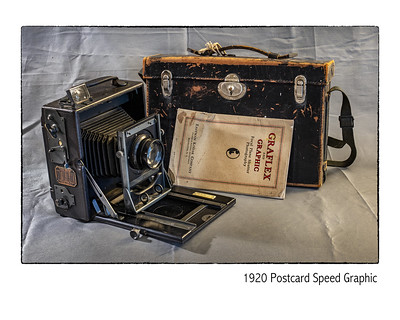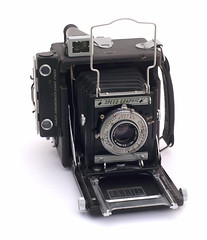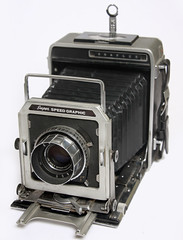Graflex Speed Graphic

|
| Pre-Anniversary Speed Graphic; side view shows settings for focal-plane shutter Note the solenoid on the lensboard. image by Rick Soloway (Image rights) |
The famous Graphic press cameras from Graflex were made in a number of variants and in several formats. "Speed" was added to the names of certain models; this refers to the high shutter speeds available from the rear focal-plane shutter--usually to 1/1000s. The "Super Speed Graphic" carried on this tradition without the focal plane shutter: instead it had an extra-high speed leaf shutter as a standard fitting that also allowed a top speed of 1/1000s. (The vast majority of leaf shutters do not go up to 1/1000s, and those that do often will not do so at wide apertures.)
These cameras are all designed for versatility. They can be solidly mounted on a tripod and used as a view camera, with a ground glass focusing screen standard on all models, or they can be used handheld with rangefinder focusing. The lenses are fully interchangeable, with lensboards available for a large variety of large-format lenses. They have various limited front movements, as outlined below, and all have bellows capable of triple extension (for long-focus lenses)--several also have special features to accommodate ultra-wide lenses.
Contents
The earliest Speed Graphics were available in 3¼x4¼, 4x5 and 5x7 formats. By 1939-1940 the 5x7 format was dropped and the 2¼x 3¼ format was added. Focal plane shutters were available from the beginning until 1970. Models with a focal plane shutter can use lenses mounted in shutters or barrel lenses (without shutters). The Pacemaker Crown Graphic, introduced in 1947, was the first model available without a focal plane shutter, followed by the Century Graphic. Otherwise these share features with the Speed Graphic series.
Models
| |||||
|
| ||||
|
| ||||
- "Top Handle" Speed Graphic
- 1912-1927 (1912-1916 by Folmer & Schwing), 3x4, 3¼ x 5 1/2 (postcard), 4x5 and 5x7. Focal plane shutter. Had very small lensboards so they are unable to use most later (large) lenses.
- "Pre-Anniversary” Speed Graphic
- 1928-1939, 4x5 and 5x7, (also 3¼ x4¼ from 1935 to 1939) Had larger lensboard. Focal plane shutter.
- "Miniature" Speed Graphic
- 1939-1946, 2¼ x 3¼. Used the Graphic (spring) back. There were Graflok back kits made that had a round depression with two contacts for the focal-plane-shutter flash-sync contacts where the peep sight usually folds down. Focal plane shutter.
- "Anniversary" Speed Graphic
- 1940-1946, 3x4, 4x5. Satin black with chrome trim except the wartime model had no chrome. Bed and body track rails were linked, allowing focusing of wide angle lenses within body. Solid wire frame viewfinder. Focal plane shutter.

|
| Pacemaker customized with massive Aero Ektar f2.5 image by Cory.Lum (Image rights) |
- Pacemaker Speed Graphic
- 1947-1970, 2¼ x 3¼, 3x4, 4x5. Mahogany/metal body. Coated lenses, lenses in shutters, body release, folding infinity stops. Side mounted rangefinder replaced by top rangefinder on 4x5" Graphics in 1955. Most Pacemakers have the Graflok back. The Graflex back (usually found on the "Graflex" SLR cameras) was an option on some Pacemaker models. Newly designed focal plane shutter. The shutter table of the old cameras with 24 speeds was changed to 6 speeds in this camera. Focal plane shutter.
- Pacemaker Crown Graphic
- 1947-1973, 2¼ x 3¼, 3x4, 4x5. Same as the Pacemaker Speed Graphic but without the focal plane shutter, resulting in a thinner, lighter camera. No focal plane shutter.
- Century Graphic
- 1949-1970, 2¼ x 3¼ only. Plastic-body. Graflok back molded as part of body. No body-mount shutter release. early models had a flat bar viewfinder, followed later by models with a flexible wire viewfinder. No focal plane shutter.
- Super Graphic
- 1958-1973, 4x5. All metal body, flash computer, electric shutter release, front standard had swing capability, revolving back. No focal plane shutter.
- Super Speed Graphic
- 1961-1970, 4x5. Same as the Super Graphic but with faster shutter (speed to 1/1000) No focal plane shutter.
Shutters
The factory setup of every Graphic model includes a lens mounted in a leaf shutter--usually a professional-model shutter manufactured by Compur in Germany or Wollensak or Kodak in the U.S. The Graphexes from Wollensak are fairly typical on 40's models, with speeds from 1/400 to 1 second, preview lever to manually open the shutter whenever it is cocked, and dipole flash sync terminals. On models with a focal plane shutter, the leaf shutter is known as the "front" shutter to differentiate between the two. Some lenses (never the default lens) do not include a shutter. These are known as barrel lenses and are used with the focal plane shutter.
Every Speed Graphic except for the Super Speed Graphic also includes a focal plane shutter. This allows higher speeds than the leaf shutter, up to a maximum of 1/1000th, giving the cameras their name. The focal plane shutter is a fairly simple mechanism, and comes in two different variations: the original version, and the simplified version of the Pacemaker Speed Graphic.
In both, a long scroll of curtain material with different-sized slits in it is wound from a spring-loaded barrel onto a barrel with a ratcheting trigger mechanism. When the appropriate slit is in position, pressing the shutter release unlatches the ratchet pawl, which allows the slit to fly across the focal plane.
In the original mechanism, the speed of the curtain is always limited by a friction governor, and the photographer chooses the shutter speed by consulting a table on top of or on the side of the camera to find a letter (A, B, C or D) and a number (between 1 and 6) corresponding to the shutter speed. The number is the tension of the shutter mainspring, which is set by a ratcheting wheel at the bottom right of the camera. The letter corresponds to one of four slits in the curtain, set by winding the shutter until the desired letter shows in a window. The shutter curtain also has a large window that uncovers the entire film gate for time exposures (and for using the front shutter when desired). Not counting time exposures, the shutter gives 24 speeds in exponentially smaller increments from 1/10th to 1/1000th. Thus, if the mechanism is well-adjusted, the photographer has precise control of the exposure, with intervals in the higher end of the scale being less than a quarter of a stop; at the extreme end (the speeds using slit D), the scale counts by hundreds from 1/500th to 1/1000th.
In the simplified mechanism, the tension of the mainspring is fixed, and the friction governor is mounted on a carriage so that it can be pulled down by a selector lever to disengage it entirely from the mechanism. There are only three slits, each of which has only two speeds: with the governor engaged and with the governor disengaged. From 24 speeds, the Pacemaker reduces the range down to six, ranging from 1/30th to 1/1000th. The large window for time exposures is also present. This version has a switch which controls the Pacemaker's special "body release:" a large button on the front right side which can fire either shutter--the focal plane shutter, directly, or the front shutter, via an internal cable linkage. The switch has three positions: "trip," "back" and "front." Trip fires the focal plane shutter--it is unclear why it is there--while the other two positions select which shutter is fired by the body release.
The final Speed Graphic is a variation of the Super Graphic sold with a leaf shutter capable of a top speed of 1/1000th of a second, thus achieving the same speed as the focal plane shutter and justifying its name. It does not have a focal plane shutter.
Backs
Graphic
The Graphic back (also known as the "Spring Back") retains the focusing screen and hood assembly to the back of the camera using a pair of wide flat springs. This permits cut film holders to be inserted between the focusing screen and hood assembly and the camera body. When the cut film holder is inserted, it pushes the focusing screen assembly back slightly. The tension of the springs holds the film holder in place.
Because there is no mechanism (other than removing a pair of screws) to permit the focusing screen to be removed, roll film holders were made to slide in place and be retained by the focusing screen, just as with cut film holders. Some roll film holders were made with a "straight through" film path. These had the supply spool on one side and the take-up spool on the other. This meant that the partially-assembled roll holder was inserted into the back and then the take-up side was assembled from the opposite (left) side. This type of roll film holder could not be removed until the roll was finished. Roll film holders with a "u-turn" film path were made. This type had the supply and take-up spools on the same side of the camera. They ran the film path over a roller. If supplied with a dark slide, they could be removed mid-roll.
On the Anniversary model, the entire Graphic back assembly could be removed from the back of the camera for replacement with a Graflok back. Graflok backs were sold by Graflex for this purpose.
Graflok
The cast-magnesium Graflok back was introduced in 1949. "Anniversary" and "Pacemaker" models that were made with Graphic backs could have Graflok backs installed. (These backs are attached to the cameras with just four screws.) Graflok backs were sold by Graflex for this purpose. All "Century" models had the Graflok back molded as part of the body. The "Super Graphic" and "Super Speed Graphic" models have rotating Graflok backs. Graflok backs can accept acecessories for either the Graphic or the Graflok back.
The Graflok back has two retention systems. Each system is a quick-release type. One system retains the focusing screen and hood assembly and the other system retains accessories such as roll film backs.
- The focusing screen and hood assembly has a pair spring-loaded arms that engage a matching pair of hooks cast into the Graflok back. Pushing in on the arms will disengage them. The focusing screen and hood assembly can then be slid slightly to the right in order to remove it from the back.
- A pair of sliding metal plates cross the back, one over the negative opening and one below. These plates engage matching slots on the removable roll film backs.
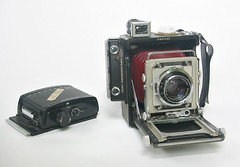
|
| Graflex Century Graphic and roll film back image by Voxphoto (Image rights) |
Cut film holders are retained under the Graflok focusing screen and hood assembly in the same manner as with the Graphic backs. Cut film holders are interchangable between Graphic and Graflok backs.
Graflex
The film folders and focusing screen and hood assembly alike are retained by a dual plate or strip system similar to that used to retain roll film backs on the Graflok back. The focusing screen and hood assembly is not spring loaded and must be removed in order to install any film holder. Graflex film holders are not interchangeable with Graflok or Graphic film holders. Graflex backs were available as an option, but are not frequently seen on Graflex press cameras.
Movements
Graflex press cameras have no rear movements.

|
| Century Speed Graphic image by Mike Novak (Image rights) |
| Model | Rise | Shift | Tilt (deg.) | Swing (deg.) | Bed drop (deg.) |
|---|---|---|---|---|---|
| Top Handle | 0 | 0 | 0 | ||
| Pre-Anniversary 4x5 | 0 | 0 | 0 | ||
| Miniature | y | 0 | 0 | 0 | |
| Anniversary 4x5 | y | y | 0 | y | |
| Pacemaker (Crown and Speed) 4x5 |
1.0 | 0.75 | 20 | 0 | 20 |
| Pacemaker (Crown and Speed) 2x3 |
0.625 | 0.375 | 20 | 0 | 20 |
| Century | y | y | y | ||
| Super and Super Speed | 1.125 | 0.5 | +/-15 | +/-25 | 15 |
Note: "y" means the movement is possible but exact figure is not available. Please help to complete this table.
Framing
Sports Finder
A sports finder was standard equipment on all Graflex press cameras. Parallax adjustment is on the hoop or the eyepiece, depending on model.
- "Automatically adjusts for most different lenses, because the hoop of the finder is the same size as the image being formed, and is at about the same distance from your eye as it is from the film, except for telephoto lenses, which are not placed their focal length away from the image plane." -www.graflex.org
Optical "Telescope" Viewfinder
This was an optional finder, also known as a "tubular" finder. The finder eyepiece rotates to provide a rough parallax correction.
This finder uses "masks" inserted behind the finder objective lens to present the "correct" field of view for different lens/format combinations. This was an approximation only, though. Note for example that the same mask is used for 2¼x2¾ and 2¼x3¼ roll film backs when a 101mm lens is used.
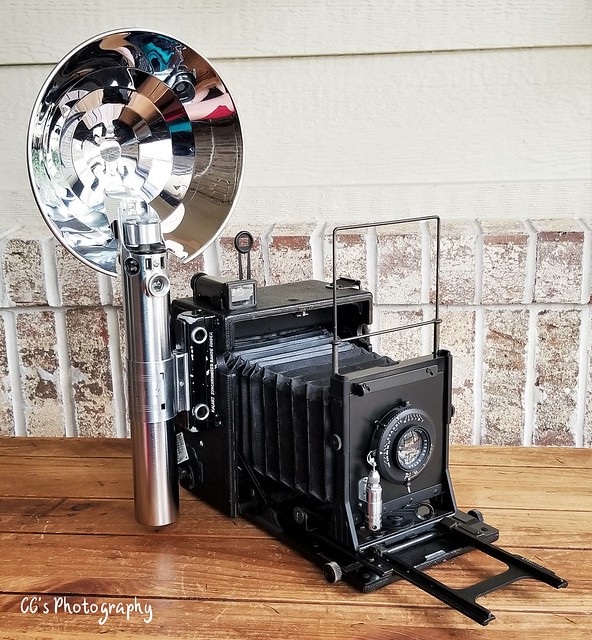
|
| Anniversary Speed Graphic (1944) Note solenoid and "Darth Vader" flashgun (Used as prop in "Star Wars) image by yashicasailorboy (Image rights) |
| Format | 2¼x2¼ | 2¼x2¾ | 2¼x3¼ | 3¼x4¼ | 4x5 |
|---|---|---|---|---|---|
| Roll back | RH-12 | RH-10 RH-20 RH-50 |
RH-8 | ||
| Catalog no. | Focal length (mm) | ||||
| 9105-4 | 70-84 | 78-82 | 114-121 | 127-149 | |
| 9105-3 | 86-90 | 83-98 | 122-133 | 150-162 | |
| 9105-2 | 92-101 | 100-114 | 135-152 | 164-168 | |
| 9105-9 | 103-125 | 116-127 | 154-178 | 170-216 | |
| 9105-10 | 127-138 | 129-152 | 179-203 | 217-241 | |
| 9105-11 | 140-162 | 154-191 | 205-216 | 243-267 | |
| 9105-8 | 164-191 | 192-197 | 217-305 | 268-343 | |
| 9105-7 | 192-227 | 198-241 | 307-352 | 344-381 | |
| 9105-6 | 229-267 | 243-302 | 354-406 | 383-429 | |
| 9105-5 | 268-305 | 303-330 | 408-508 | 431-508 | |
| 9105-12 | 100-114 | ||||
| 9105-13 | 243-302 | ||||
| 9105-14 | 116-127 | ||||
| 9105-15 | 129-152 | ||||
| 9105-17 | 154-191 | ||||
| 9105-20 | 78-90 | ||||
| 3060 W.A. Adapter |
47-69 | 47-75 | 82-98 | ||
Source: Rapid-Vance 120 Roll Film Holder Guidebook (1967)
Focusing
There are several options for focusing a standard Graphic camera as well. All the standard backs had a ground glass, which allows for direct viewing and focusing. This can be cumbersome when shooting handheld, so almost all Graphics (except early models) come with a rangefinder installed. These normally operate by a large spring-loaded arm inside the camera housing, which touches a cam mounted on the focusing rack. The focus can be calibrated by turning the cam with a flathead screwdriver, changing the position of the infinity stops on the focusing rack, or in some cases by adjusting the rangefinder mechanism directly.
Kalart made the standard side-mounted rangefinder module for many of the Graphics. This rangefinder has a round spot in a round window. It does not have any magnification or lenses in it, so there is no defined eye relief for this lens: one can look through it with one's eye far from the eyepiece and still focus properly. The Kalart housing also doubled as a hard point for mounting flashguns. A small light, connected to the flashgun batteries, could be attached to the rangefinder and reverse the operation of the rangefinder, projecting two spots that would coincide on an object when it was in focus.
Later, some Graphics had rangefinders made in-house, including a modular rangefinder designed after the Kalart and the integrated viewfinders on the later models.
Lastly, if the distance scale on the focusing rack is calibrated properly, the camera can be focused by setting the distance manually.
Other features
Various models of the Speed Graphic had front-shutter solenoids available as an option. This is a small electromagnetic device that pulls on an internal piston to directly trigger the front shutter. This would be connected to a "solenoid" port on various flashguns, such that pressing a trigger on the flashgun would fire the shutter and/or fire the flash. This allowed non-synchronized front shutters to be used with a flash, as the solenoid is adjustable. The firing of the shutter can thus be timed to coincide with the firing of the flash. This is an early but reliable method of flash sync.
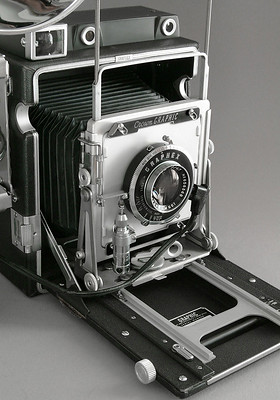
|
| Crown Graphic 4x5 with solenoid image by Geoff Harrisson (Image rights) |
The Pacemaker Speed Graphic had dipole flash synchronization on its default front shutter (for any speed) and on its back shutter (for using flat-peak bulbs at speeds of 1/120th or below.) It was also commonly equipped with the solenoid.
On cameras from the Anniversary and Pacemaker lines (and to some extent the later Graphics as well), there were cumbersome but usable provisions for extra-wide lenses (which would normally get the edge of the folding bed in frame): the bed can be dropped by 20 degrees by pressing on the struts and pulling it further down, normally giving a few degrees of tilt and a minor shift--however, with the extremely short bellows draw of most extra-wides, the carriage and front standard will actually still be on the small back rack, behind the bed hinges, and thus will not be tilted or dropped at all--and the bed will be out of the field of view of the lens. As the racks are linked and move together, the focusing knobs will still be usable. The frame finder will not be usable, as it will be impossible to open with the front standard still inside the body of the camera, so viewing and focusing will be by the ground glass.
Side-to-side shift is well hidden on the Pacemakers. The rack clamp (ring lever under front standard) must be loosened, and a spring-steel catch under this lever must be held down. The standard-carrier is now loose to move from side to side, but with a normal or wide lens, the struts will restrict the range of movement in most circumstances except extreme closeup. Most non-tele long lenses (with long bellows draw) will clear the struts.
On almost all Graphics (with the exception being the Supers) the lensboard is retained by either one or two clips, which slide diagonally over either the top, or the top and bottom edges of the lensboard. The lensboards are generally not interchangeable from model to model and between sizes of the same model, with exceptions. There was a practice among some photographers of mounting the lensboards on certain models upside-down, allowing easy access to the aperture lever. This sacrifices the use of the internal cable release on the Pacemaker et al, and makes cocking and firing the front shutter unwieldy, so it was mostly used by photographers who preferred the rear shutter.
The camera was often sold with a leather strap to allow the photographer a firm grip with his or her left hand. Many flashguns clip directly on to the lugs for this strap, or alternatively to a plate attacked to the housing of the side-mounted rangefinder, where applicable; if the photographer wished to use his or her right hand to operate the flash.
References
- http://www.graflex.org/
- http://en.wikipedia.org/wiki/Speed_Graphic
- Graflex Rapid-Vance 120 Roll Film Holder Guidebook (pdf)
- Crown Graphic Special video presentation by YouTuber Kay's Cameras
Links

|
| Anniversary Speed Graphic (1944) image by yashicasailorboy (Image rights) |
- Speed Graphic Nude: What's underneath their clothes?
- Super Graphic: Best Buy in 4x5 Field Cameras
- Super Graphic Conversion to Technical Camera
- Enter the World of Graflex all about Graflex Press Cameras
- Graflex instruction manuals, English at Butkus.org
- Graflex Speed Graphic at Classic Cameras by RaúlM.
In French:
- Anniversary , Combat 45 USMC,Combat 45 Navy ,Crown Graphic ,K20 aircraft on www.collection-appareils.com by Sylvain Halgand (in French)
